Website Maintenance: A Guide for Growing Businesses
Your website is your number #1 marketing asset.
They are a 24/7 salesperson, and the first impression you’ll make on potential customers. 94% go online first before making a decision.
But business owners and marketing leaders often make a mistake - thinking it’s a ‘set and forget’ asset.
Just like a physical store, your website needs regular attention to keep it running smoothly, securely, and effectively. Neglecting website maintenance can lead to lost revenue, security breaches, and a damaged reputation.
This guide explores why website maintenance is crucial, what it involves, how to monitor your site if you’re doing it yourself, the benefits of outsourcing to experts, and ways to keep costs down.
Why you need Website Maintenance
Website maintenance ensures your online presence remains a powerful tool for growth.
Here’s why it’s so important:

1. Positive User Experiences
First impressions count. A slow, buggy, or hard-to-navigate website will frustrate visitors and send them straight to your competitors.
A well-maintained website, on the other hand, provides a seamless and enjoyable user experience, which is crucial for keeping potential customers engaged.
A website that is difficult to navigate and has broken links or slow loading times can result in a poor user experience and deter users from returning.
According to a study by Google/SOASTA, 53% of mobile users abandon a site if it takes longer than 3 seconds to load, and a 1-second delay can drop conversions by up to 7%.
2. Safeguard Your Website From Hackers
Cybersecurity threats are a significant risk for businesses of all sizes.
Outdated software and plugins are a primary target for hackers. The 2023 Sucuri Hacked Website and Malware Threat Report found that 39% of all hacked websites were running out-of-date core software.
Getting hacked doesn’t just damage your website — it can come with serious costs. In Australia, the average cost of a data breach hit AUD $4.26 million in 2024, according to IBM’s Cost of a Data Breach Report.
Regular maintenance, including security scans, software updates, and backups, is your first line of defence against malicious attacks, protecting both your business and your customers' sensitive data.
3. Boost Your Online Visibility (SEO)
Search engines like Google reward websites that are well-maintained, fast and regularly updated.
Keeping your site fresh through content updates, performance tuning and technical fixes tells Google that your site is active, relevant and worth showing to users.
According to Google’s official SEO starter guide, providing high-quality content, ensuring fast load times and offering a mobile-friendly experience are all essential signals for better rankings.
In short, proactive website maintenance doesn’t just keep things running – it helps you get found by more people, more often.
4. Prevent Costly Downtime
Every minute your website is down, you're losing potential customers and revenue.
Website downtime can also damage your brand's reputation and credibility.
Proactive maintenance helps prevent the technical issues that cause downtime and ensures that if problems do arise, they are resolved quickly and efficiently.
5. Build Trust and Credibility
A well-maintained website that is secure, up-to-date, and easy to use reflects positively on your business.
It shows that you are professional, reliable, and committed to providing a quality experience for your customers. This builds trust and credibility, which are essential for long-term customer relationships and brand loyalty.
Seven Core Website Maintenance Tasks
These are the seven maintenance tasks that need to be performed regularly to keep your website in top shape.
While some can be done in-house, many require technical expertise.
1. Weekly Backups
Regularly backing up your website’s files and database is non-negotiable.
If your site is hacked, or an update causes a major issue, a recent backup is your safety net, allowing you to restore your site quickly and minimise downtime.

2. Software Updates
This includes updating your website’s core software (like WordPress or Joomla), as well as any plugins, extensions, or themes.
These updates often contain critical security patches, bug fixes, and new features. As highlighted by HubSpot, failing to apply updates is a major security risk.
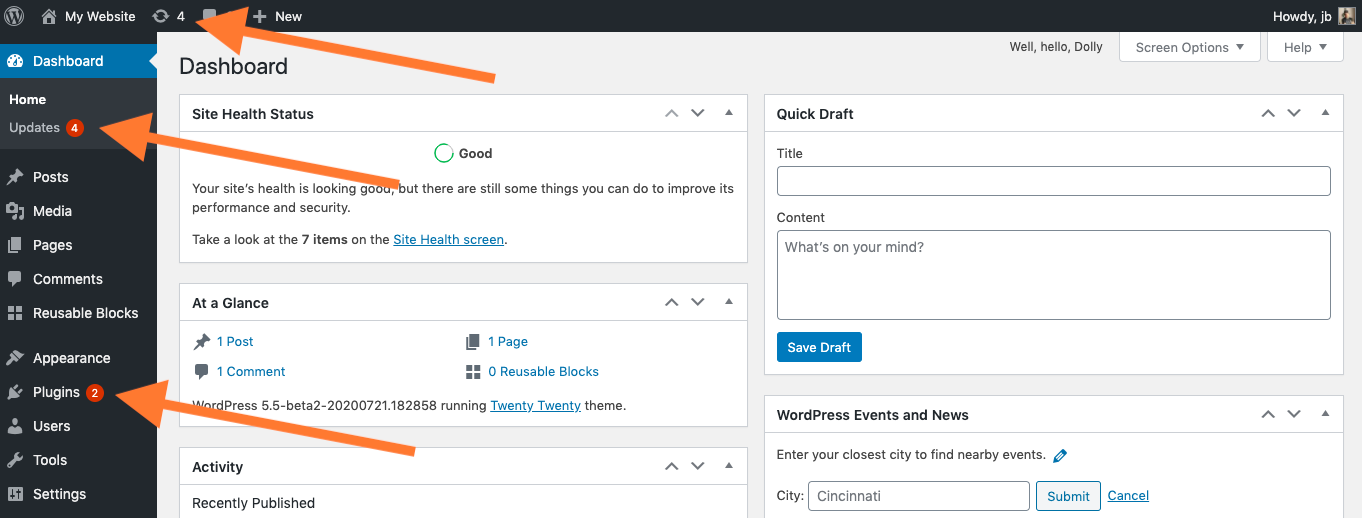
3. Security Scans
Regularly scanning your website for malware and other security vulnerabilities is essential for protecting your site and your customers. Many security plugins and services can automate this process.
One recommended tool is Security Headers by snyk, which quickly checks whether your site uses essential HTTP response headers like Content-Security-Policy and Strict-Transport-Security.
These headers help protect against common threats such as cross-site scripting (XSS), clickjacking, and code injection.
By scanning and fixing missing or weak security headers, you reduce your exposure to malicious attacks and improve trust with both users and search engines.
4. Performance Checks
Your website’s loading speed has a direct impact on user experience and SEO.
Regularly testing your site’s performance and optimising images, code, and server response times is crucial for keeping it fast and responsive.
You want to focus on mobile Core Web Vitals first, as Google uses mobile-first indexing. Consider using Australian-based CDN services to improve loading times for local users.
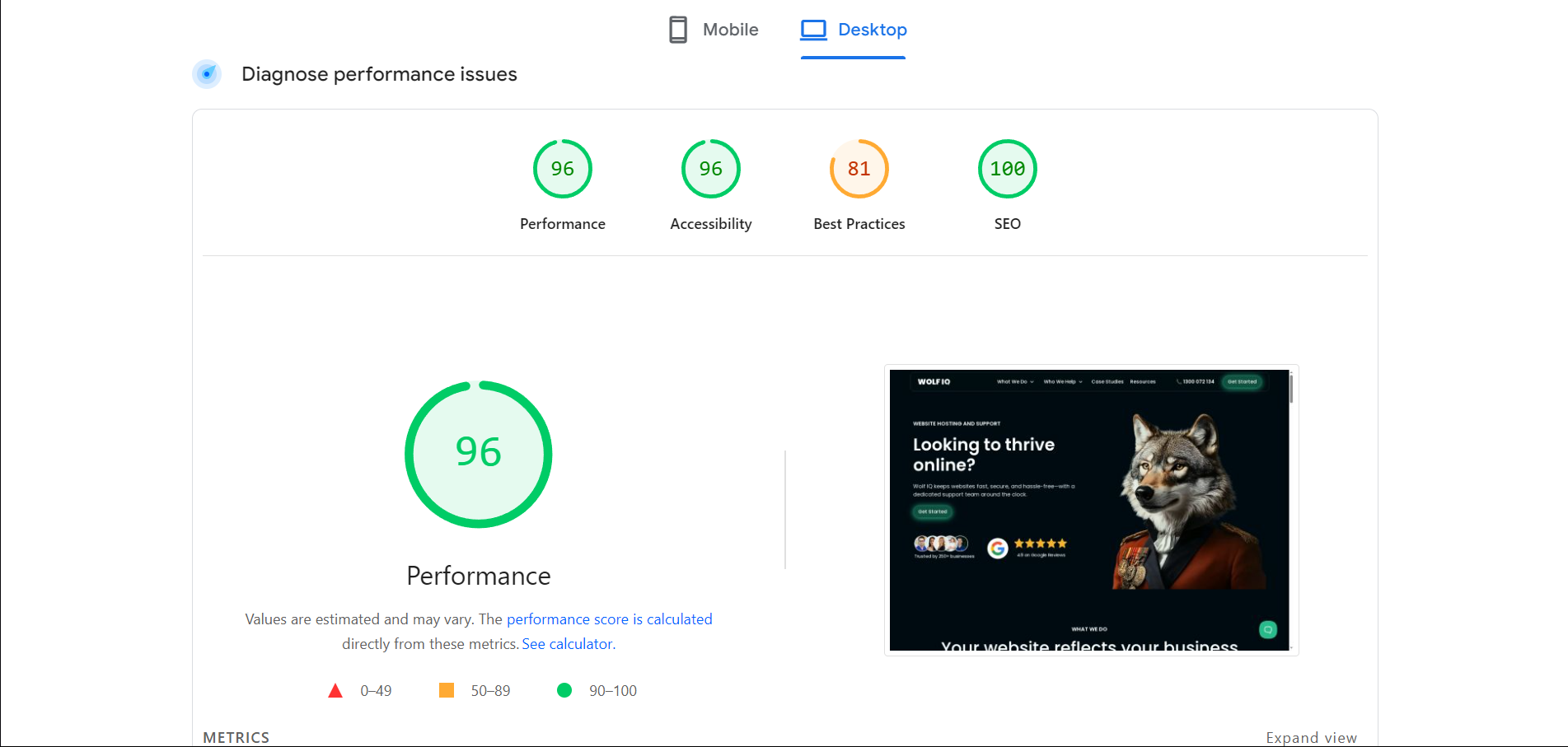
5. Broken Link Checks
Broken links create a frustrating user experience and can harm your SEO. Regularly scanning your site for broken links and fixing them promptly is a simple but important maintenance task.
We recommend Dr. Link Check because it’s free, fast, and provides a detailed report showing which anchor text contains each broken link.
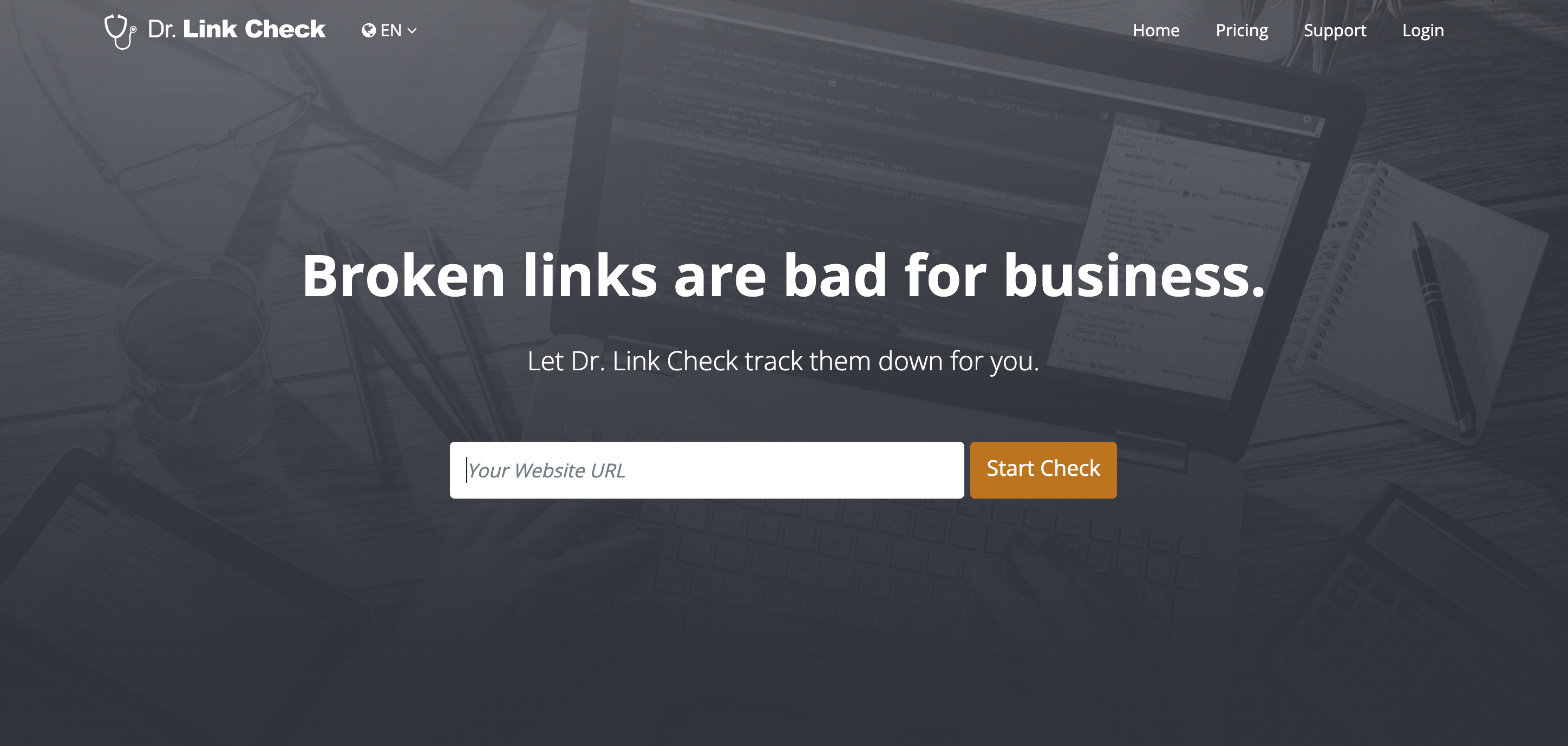
6. Content and SEO Updates
Keeping your website’s content fresh and relevant is key to engaging your audience and improving your search engine rankings.
This includes adding new blog posts, updating existing content, and optimising for relevant keywords.
7. E-commerce Maintenance
For online stores, maintenance also includes managing product listings, updating pricing and inventory, and ensuring that your payment gateway and shipping integrations are working correctly.

DIY vs. Outsourcing: What’s Right
A key decision for any business is whether to handle website maintenance in-house or outsource it to a professional agency.
There are pros and cons to both approaches, and the right choice depends on your budget, technical expertise, and the complexity of your website.
The DIY Approach
If you have the time and technical confidence, you can certainly handle some basic maintenance tasks yourself. This can be a cost-effective option, especially for simple websites. If you go the DIY route, here are the key things you need to monitor:
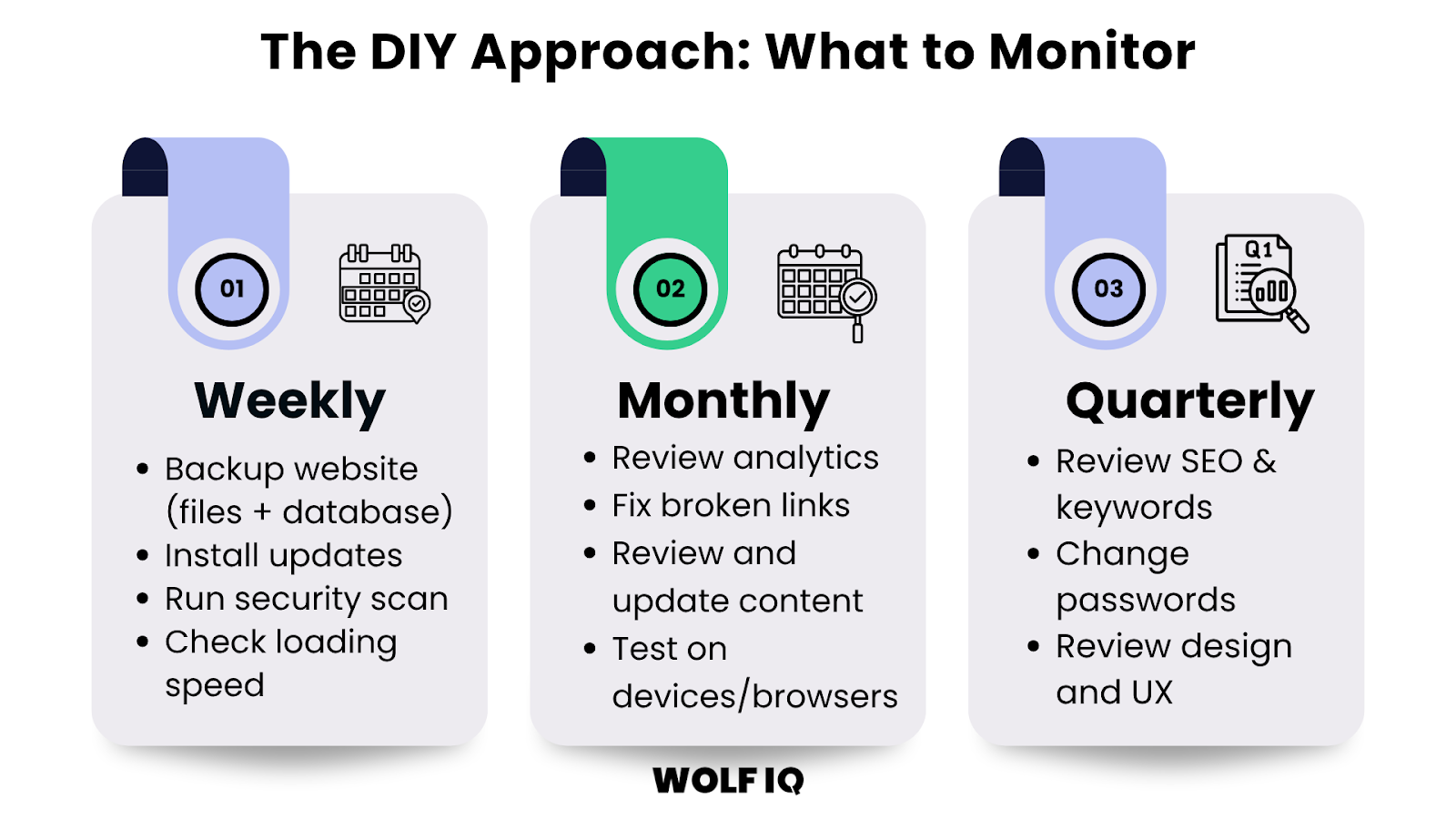
1. Weekly Checklist:
- Run a full backup of your website (files and database).
- Check for and install any software, plugin, and theme updates.
- Run a security scan to check for malware.
- Check your website’s loading speed using a tool like Google PageSpeed Insights.
2. Monthly Checklist:
- Review your website’s analytics to track traffic, user behaviour, and conversions.
- Check for broken links and fix them.
- Review and update your website’s content.
- Test your website on different devices and browsers to ensure it’s responsive.
3. Quarterly Checklist:
- Review your SEO strategy and keyword rankings.
- Change your passwords (admin, FTP, hosting).
- Review your website’s design and user experience. Is it still meeting your customers’ needs?
Outsourcing to Web Design Experts
While DIY can save you money, it can also be time-consuming and risky if you’re not sure what you’re doing.
For many small businesses, outsourcing website maintenance to a professional agency is a smarter investment. Here’s why:

- Expertise and Experience: A professional agency has the technical expertise to handle all aspects of website maintenance, from security and performance to SEO and content updates. They know what to look for and how to fix problems quickly and efficiently.
- Time Savings: Outsourcing frees you up to focus on what you do best – running your business. You don’t have to worry about the technical details of your website.
- Proactive Approach: A good maintenance provider will take a proactive approach, identifying and fixing potential issues before they become major problems. This can save you from costly downtime and security breaches.
- Peace of Mind: Knowing that your website is in the hands of experts gives you peace of mind. You can be confident that your site is secure, up-to-date, and performing at its best.
4 Ways to Keep Website Maintenance Costs Down
Whether you choose to DIY or outsource, there are several strategies you can use to keep your website maintenance costs under control.
Thinking about maintenance from the very beginning of your website project is key. Here is how:
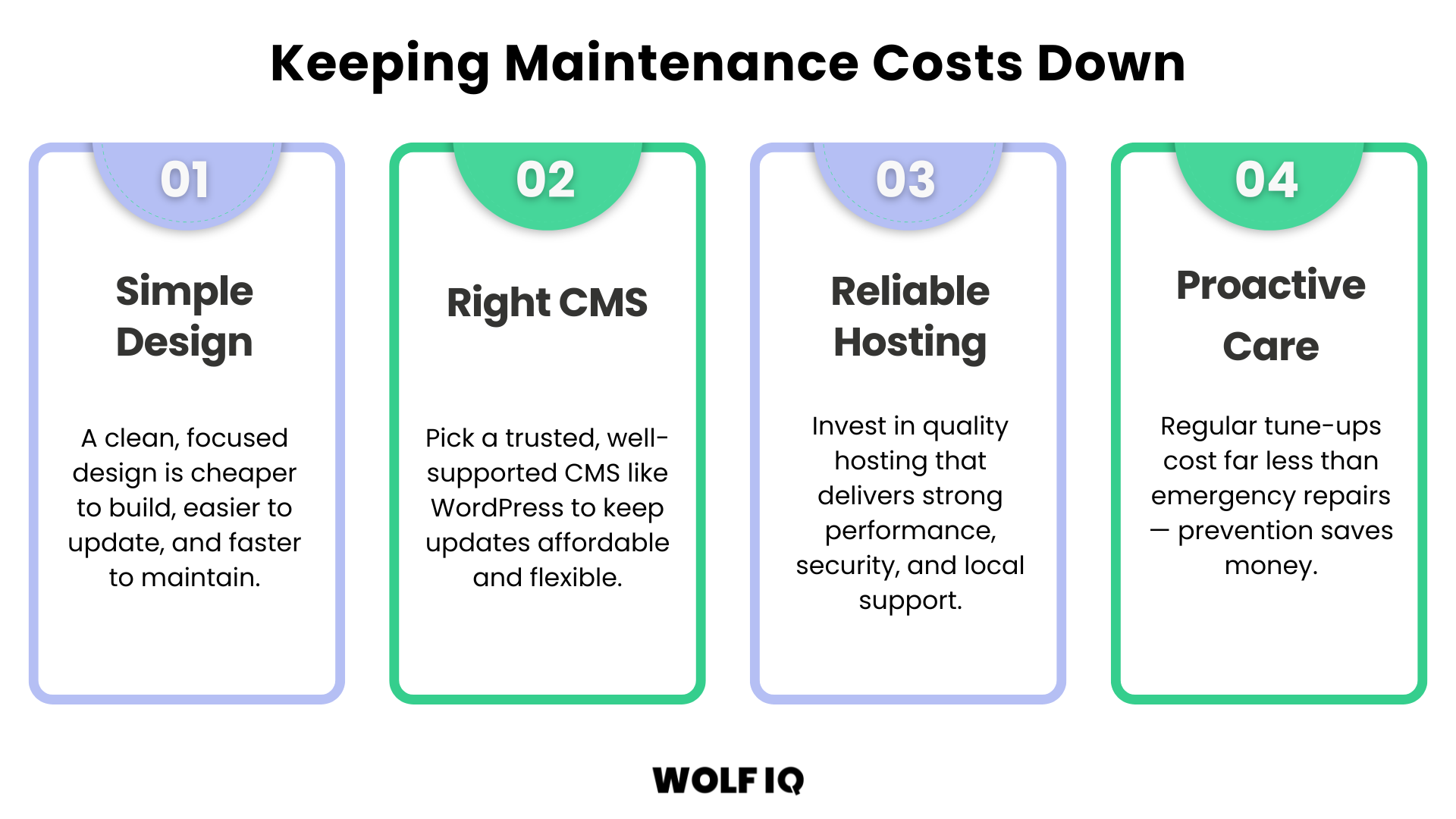
1. Simple Website Design
A simple, clean website design is not only more user-friendly, but it’s also less expensive to maintain.
Complex designs with lots of features and custom functionality require more time and resources to update and troubleshoot.
By focusing on the core functionalities your business needs, you can reduce both your initial development costs and your ongoing maintenance expenses.
2. Choose the Right Platform (CMS)
Using a popular and well-supported Content Management System (CMS) like WordPress can significantly reduce your maintenance costs.
WordPress is open-source (free to use) and has a massive global community of developers who create affordable plugins and provide support. This means you’re not locked into a single developer or agency for updates and support.
3. Reliable, Cost-Effective Hosting
Your choice of web hosting has a big impact on your website’s performance, security, and maintenance costs.
While cheap offshore hosting providers can be tempting, it often comes with poor performance and limited support. You want a reliable and local hosting provider that offers good performance, security features, and responsive support.
4. Proactive with Maintenance
It’s much cheaper to prevent problems than to fix them.
A proactive approach to maintenance, including regular backups, updates, and security scans, can save you from costly emergency repairs down the track. Think of it like servicing your car – regular tune-ups are much cheaper than a major engine failure.
Website Maintenance Cost Breakdown
So, how much should you budget for website maintenance?
The cost can vary widely depending on the size and complexity of your site, but here’s a general guide:

- Basic Maintenance (for small, simple websites): $100 - $300 per month. This typically includes weekly backups, software updates, and security scans.
- Standard Maintenance (for most SMBs): $300 - $800 per month. This usually includes everything in the basic plan, plus performance monitoring, content updates, and technical support.
- Advanced Maintenance (for e-commerce or complex sites): $800 - $4,500+ per month. This is for businesses that need comprehensive support, including advanced security, e-commerce management, and dedicated developer time.
These prices can vary significantly because websites do too. So whichever path you choose, it’s important to get a detailed quote that outlines exactly what’s included.
Your Website is your #1 Marketing Asset
Your website is a powerful tool for growth, but only if it’s properly maintained.
By investing in regular website maintenance, you’re not just preventing problems — you’re building a faster, safer, and more profitable online presence. Whether you manage it in-house or outsource to specialists, a proactive approach is essential.
Need a hand? Wolf IQ offers tailored website maintenance solutions designed to keep your site secure, high-performing, and conversion-ready.
Book Your Free Strategy Session today to get a no-obligation audit of your current site, identify critical maintenance gaps, and receive a practical action plan to keep your website running at its best.
Wolf IQ helps hundreds of businesses win online every month.


.png)




.png)
.png)


.png)

